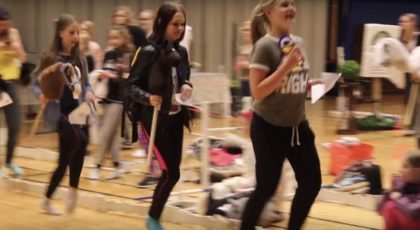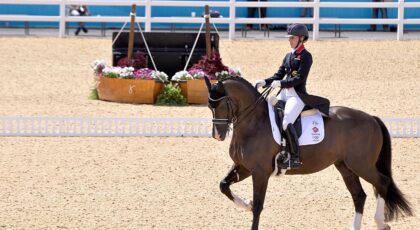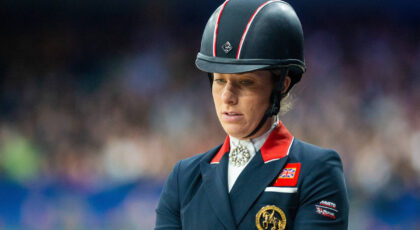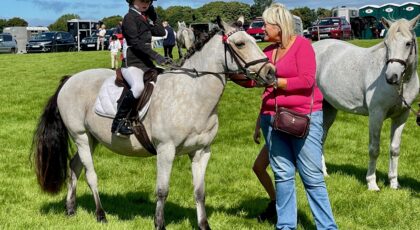If you’ve ever sat on a stiff horse, you know it’s not a comfortable ride. But have you ever considered that it’s not comfortable for the horse either? When your horse is hollow and stiff, he cannot use his body correctly. It’s hard for them to stop. It’s hard for them to turn. It’s hard for them to carry your weight. Do it long enough and it’s hard on their body too. On the contrary, when your horse is round, they will relax and use their body properly, allowing you to control and maneuver them with ease! Here, dressage trainer Amelia Newcomb explains why roundness is so important for your horse and for your relationship with your horse.
* * * *
Has your trainer ever told you that your horse needs to be rounder? There’s a good reason for that. If your horse isn’t round, you’re physically making it more difficult for him to do his job.
Let me explain.
Roundness reshapes the horse’s topline, making it easier for them to carry the weight of the rider and to respond to the aids. The hind end folds under, the back and withers lift and the neck arches upwards.
This shape creates a flow of energy between the horse and rider. When you put your leg on, you create energy in your horses hind legs and then that energy should flow up through your horse’s back through your horse’s neck and then back to your hands.
When the horse’s body is organized in this way, it makes it easier for them to turn, to stop, and to circle, and for you to ride transitions with ease. Physical roundness also creates a mental state in which your horse is willing and focusing on you and your aids. And that is really important.

To understand why roundness is actually more comfortable, both for the horse and the rider, it’s important to understand a little bit about your horse’s anatomy.
First, let’s look at the musculature.
This is an illustration of the longissimus muscle—that’s what we call the long back muscle that goes from the fourth neck vertebrae in the horse’s neck all the way to the sacrum. (In other words, from just under the poll to the pelvis.)

We want the horse to lift and engage this muscle when we’re riding them, so that we’re sitting on our horse’s muscles as opposed to resting our weight on their ribs or their spine, which you can imagine has got to be uncomfortable for the horse.
When you ride your horse round and connected, it develops this muscle and the horse’s top line, which allows them to more comfortably carry us and perform the moves we ask of them.
There is also the skeletal side of things to consider.
This is a photo of Kissing Spine.

The blue arrows show where the horse’s vertebrae are actually pressing against each other. As you can imagine that is very uncomfortable for the horse. Riding your horse round lifts up his back and allows there to be more space in the vertebrae, making riding more comfortable for a horse with Kissing Spine. It can also help prevent a horse from developing Kissing Spine.
Are you ever done working on roundness?
The answer is no.
Roundness is something we are always trying to improve. As you move up the levels, you’re always working on refining the connection and getting your horse rounder and really using themselves.
Take Lottie Fry and Glamourdale, for example. Roundness is what enables them to perform really difficult movements and what allows them to have so much expression. Lottie has been riding Glamourdale since he was six, so it’s years and years of training to develop and refine the roundness, and also to develop the horse’s muscles and the horse’s body.
Roundness is not just for dressage, either.
Roundness is what permits a hunter to float across the ground on the flat and to use their body and snap knees over a fence. It’s what allows a jumper to turn on a dime and elastically adjust its stride in a jump off. It’s what enables a reining horse to spin and a cutting horse to cut.
Most importantly, roundness is what allows horses to do all these things comfortably and willingly.
So now you know why roundness is so important.
The next step is creating it.
Roundness begins with establishing contact and connection. So that’s where we start.
We want the contact to the bit to be elastic and adjustable and for the horse to accept the bit through acceptance of the aids. There’s a formula that I use with every single horse to train them to accept the contact. Each horse is different, of course. So within that formula, you have to change things a little bit based on your horse’s instinct.
To assess where you are, what you need to work on, and what you are missing, download my FREE Contact & Connection Webinar and Worksheet. In less than 30 minutes, you will have a deeper understanding of what your horse needs from you and be well on your way to getting your horse more round!
Want to dive deeper? Join Amelia Newcomb’s 30 Days to Round Challenge this September and learn how to get your horse on the bit with simple step-by-step instructions that you and your horse understand.





 August 30, 2023
August 30, 2023 




























